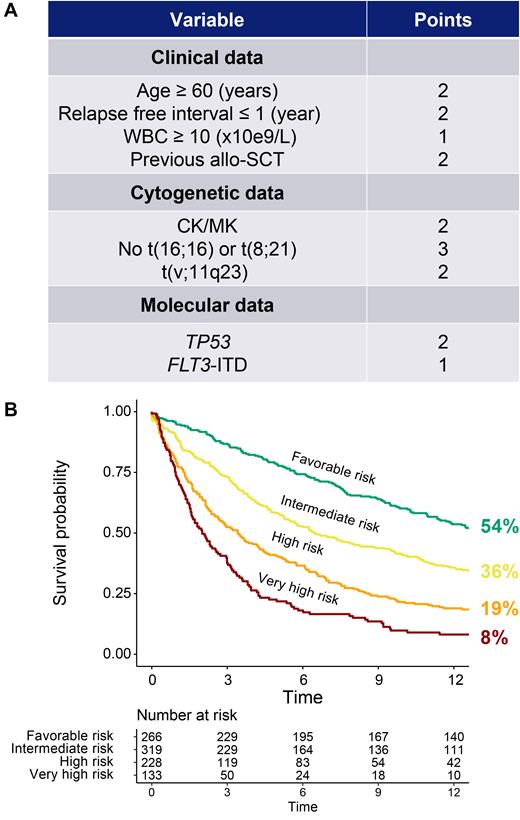Introduction
Despite high rates of complete remission (CR) after intensive induction chemotherapy in newly diagnosed AML, relapse is frequent and associated with poor outcome with a median overall survival (OS) of 3-5 months. While cytogenetic and molecular markers are associated with outcome in newly diagnosed patients, the prognostic value in the relapsed setting is unclear, even though it may facilitate therapeutic decision making. Genetic data was only limitedly available when earlier models for relapsed patients were developed, such as reported by HOVON-SAKK (Breems, JCO 2005) and GOELAMS (Chevallier, Leukemia, 2011). Therefore, a comprehensive analysis of clinical, cytogenetic and molecular variables in a prognostic model for outcome after relapse is needed. We set out to evaluate the impact of these variables on outcome after first relapse in the current therapeutic era, and develop a new prognostic model and compare that model with earlier models.
Methods
A total of 946 (44%) relapsing patients out of 2127 newly diagnosed AML patients who participated in prospective HOVON-SAKK trials of intensive induction chemotherapy between 2000-2018 were included in this analysis. A random survival forest machine learning algorithm was used to identify top markers impacting 1 year survival after relapse among 45 candidate predictors, including 7 clinical parameters, and 9 cytogenetic and 29 molecular abnormalities present at diagnosis. Cox regression with backward selection was performed to obtain hazard ratios (HRs) from relevant predictors identified by the random survival forest algorithm. A clinical prognostic tool was developed with points assigned to each marker based on the rounded logarithm of HR. Four groups were defined based on quartiles of the individual predictions. Prognostic accuracy of risk models was assessed using Harrel's C-index.
Results
The median age of relapsed patients was 58 years (range: 18-81), with 56% being male. Adverse risk AML according to ELN2022 risk was found in 48% of patients, whereas favorable and intermediate risk were classified in 22% and 31%, respectively. Prior allogeneic stem cell transplantation (SCT) in first CR was performed in 33% of patients, while 14% received autologous SCT. The median time between CR and relapse was 14 months (range: 0-124). The median follow-up time after relapse for patients alive was 49 months (range: 0-124). The random survival forest identified 16 parameters that were associated with 1 year OS based on variable importance, including: age at relapse ≥60 years, relapse-free interval ≤1 year, white blood cell count ≥10 x 10e9/L at diagnosis, prior allogeneic SCT, absence of t(8;21)/inv16, and presence of complex or monosomal karyotype (CK/MK), -5 or del(5q), -7, t(v;11q23), chromosome 17 alterations (-17, del(17p) or abn(17p)), FLT3-ITD, and mutations found in either TP53 with VAF ≥10%, DNMT3A, EZH2, NPM1, or NRAS. From these parameters, nine remained significant with Cox regression: age (HR 1.48, p<0.01), relapse free interval ≤1 year (HR 1.74, p<0.01), white blood cell count ≥10 x 10e9/L at diagnosis (HR 1.23, p=0.02), prior allogeneic SCT (HR 1.58, p<0.01), CK/MK (HR 1.53, p<0.01), no t(8;21)/inv(16) (HR 2.34, p<0.01), t(v;11q23) (HR 1.51, p=0.02), mutated TP53 with VAF ≥10% (HR 1.70, p<0.01), FLT3-ITD (HR 1.32, p<0.01). Next, weights were assigned to these variables based on the multivariate HRs (Figure 1A). Scores were calculated for individual patients and four groups were defined. OS at 1 year estimated 54±3% in the favorable risk group (≤5 points), 35±3% in the intermediate group (6-7 points), 18±3% in the high risk group (8-9 points), and 8±2% in the very high risk group (≥10 points) (Figure 1B). The prognostic accuracy for 1 year OS as measured by the C-index was 0.70. In contrast, in this cohort C-indices for the HOVON-SAKK and GOELAMS models were 0.65 and 0.64, respectively. In addition, comparing the earlier models with the new model, 50% of patients in the adverse group of the HOVON-SAKK model were classified to the favorable (14%) and intermediate group (36%) in the new model. In the GOELAMS model, 42% of intermediate risk patients were considered high (10%) or very high risk (32%) in the new model.
Conclusion
Analysis of clinical, cytogenetic and molecular variables identified nine variables for a new prognostic model which was associated with distinct OS at 1 year after first AML relapse and improved prognostic accuracy.
Disclosures
Biemond:BMS: Research Funding; Novartis: Other: Advisory board, Research Funding; Novo Nordisk: Other: Advisory board; CSL Behring: Other: Advisory board; Celgene: Other: Advisory board; Sanquin: Research Funding; Global Blood Therapeutics/Pfizer: Other: Advisory board, Research Funding. Versluis:ExCellThera: Consultancy; AbbVie: Honoraria.


This feature is available to Subscribers Only
Sign In or Create an Account Close Modal